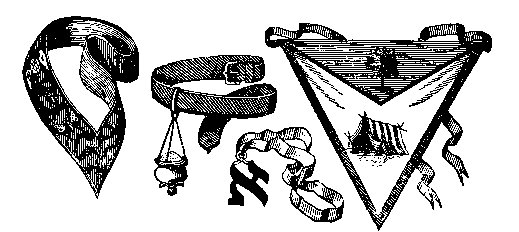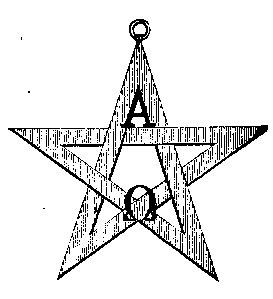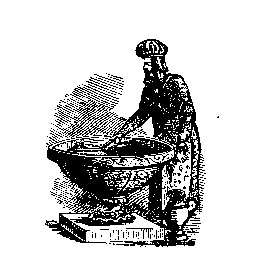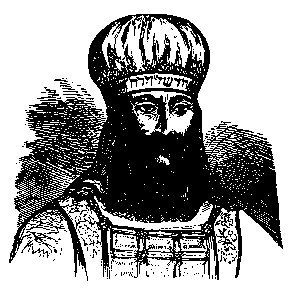The Web of Hiram |
Degrees of the Ancient and Accepted Scottish Rite14. Grand Elect, Perfect and Sublime Master Mason 15. Knight of the East or Sword 17. Knights of the East and West 18. Knight of the Rose-Croix de Heredom 20. Grand Master of all Symbolic Lodges 21. Noachite or Prussian Knight 25. Knight of the Brazen Serpent 29. Knight of St Andrew, or Patriarch of the Crusades |
PRINCE OF THE TABERNACLEThe Twenty-Fourth Grade of the Ancient and Accepted Scottish Rite and the Sixth Degree of the Historical and Philosophical Series
ARGUMENTThe degree of Prince of the Tabernacle illustrates the ceremonies of the Priests in the ancient Temples, and explains the esoteric meaning of their many avocations in equipping the Temple and sustaining their various sacerdotal duties. This degree is most intimately connected with, and should be considered a continuation of, that of the Chief of the Tabernacle. The especial duties of a Prince of the Tabernacle are to labour incessantly for the glory of God, the honour of his country, and the happiness of his brethren; to offer up thanks and prayers to the Deity in lieu of sacrifices of flesh and blood. THE COURT-ITS DECORATIONS, ETCThe Hall consists of two apartments. The first, which is the smaller, adjoins the second, and is called the Vestibule, where the brethren clothe themselves. It is furnished at all points like a Master Mason's Lodge, except that instead of a printed Bible, a roll of parchment, representing the Book of the Law, lies on the altar, upon the Book of Constitutions; and that the letter Yod is suspended in the East, instead of the G. The second apartment is furnished in every respect like the Principal apartment in the 23d degree, with these additions: In the East is suspended the Pentagram, or Blazing Star, in the following shape, of vermilion, illuminated as a transparency:
There are two sets of hangings around the room, one red and the other black. On the table of shew-bread, in the Tabernacle, is a silver vessel containing perfumed oil.
OFFICERS AND CLOTHINGThe Assemblage is styled "The Court." The presiding officer represents Moses, and is styled "Most Puissant Leader." He sits in the East. Near him, on his right, is the second officer, who represents Eleazar, the High-Priest, the son of Aaron. He is styled "Most Excellent High-Priest," and wears the full-dress of his office, as described in the 23d degree. On the left of the Leader sits the third officer, clothed as the Priests in that degree, and representing Ithamar, the son of Aaron. He is styled "Excellent Priest."
The Orator represents the Puissant Prince Eliasaph, the son of Lael, of the house of Gershon, and sits in the West. The Secretary represents the Puissant Prince Eliazaphan, the son of Uzziel, of the house of Kohath, and sits to the south of the Tabernacle. The Treasurer represents the Puissant Prince Zuriel, the son of Abibael, of the house of Merari, and sits to the north of the Tabernacle. The Expert represents Aholiab, and sits to the right of the Leader, in front. The Assistant Expert represents Bezeleel, and sits to the right of the Orator, in front. The Grand Master of Ceremonies represents Caleb, the son of Jephunneh, and sits facing the Leader in front of the Tabernacle. The Grand Captain of the Guards represents Joshua, the son of Nun, and sits on the right side of the Tabernacle, facing the East. All the officers, except the Leader and Wardens, and all the other members, are styled "Levites" and these officers and members all wear a turban of white muslin; broad, watered scarlet ribbon, worn from right to left; a girdle of red leather, fringed below with gold, and edged with gold-lace, from which girdle a small silver censer is suspended. (See 23d degree.) On the front of the ribbon are embroidered, in gold, a winged globe, and under it a scarabaeus, under which in a brilliant butterfly; all symbols of immortality. The apron, which is not worn by the first three officers, is of white lambskin, lined with scarlet, bordered with light green, and the flap with light blue. In the middle of the apron is printed a representation of an Arabian tent, in gold; and on the flap a representation of a myrtle-tree, of violet color. The jewel is the letter N, suspended from a short collar of narrow, watered, violet-colored ribbon. The Most Puissant Leader wears a tunic of blue silk, its collar decorated with rays of gold representing a glory, and the body of it sprinkled with stars of gold. On his head he wears the white turban, with a purple band round the forehead, embroidered with stars of gold; and also surmounted by a small triangle of gold, the apex downward. RECEPTIONMy brother, the initiate is he who possesses the lamp, the cloak, and the staff. The lamp is reason enlightened by science; the cloak is liberty, or the full and entire possession of one's self, which isolates the sage from the currents of instinct; and the staff is the assistance of the occult and eternal forces of nature. The lamp lights the past, the present, and the future, which are the three sides of the triangle. It burns with a threefold flame; the cloak is in three folds; and the staff is divided into three parts. This number, nine, is that of the reflexes of the Deity, and expresses the divine idea in all its abstract power. Hence it is sacred in Masonry. For that it was that Hermes made it the number of initiation; because the initiate reigns over superstition, and by superstition, and can walk alone in the darkness, supported as he is upon his staff, wrapped in his cloak, and lighted by his lamp. Reason has been given unto all men; but all do not know how to use it. That is a science that must be learned. Liberty is offered to all; but all have not the power to be free. That is a right which we must conquer. Force is within the reach of all men; but all men do not know how to lean upon it. That is a power of which one must possess himself. These are to us, in this degree, the three great lights on the east, west, and south of the altar. To attain the Holy Empire, that is to say, the science and power of the Magi, four things are indispensable: an intellect enlightened by study; an audacity which nothing checks a will that nothing can conquer; and a discretion that nothing can corrupt or intoxicate. To Know, to Dare, to Will, to be Silent - these are the four words of the Magus, written in the four symbolic forms of the sphinx. All the phenomena of nature depend on one single immutable law, represented by that symbolic form, the cube; and this furnished the Hebrews with all the mysteries of the divine tetragram. Take care that thou dost not mistake the shadow for the reality. In everything, the vulgar habitually do so. They turn from the light, and wonder at the obscurity which they themselves project. Listen and learn. Interpret our symbols for yourself. In every rough ashlar of marble is hidden the perfect cube. One is the symbol, the other its meaning. The sun and moon in our lodges are the truth, and the reflection of the truth in doctrine. Allegory, the mother of all dogmas, is the substitution of the impression for the seal, of the shadow for the reality. It is the falsehood of the truth, and the truth of the falsehood. A dogma is not invented; a truth is veiled and a shadow produced, to suit weak eyes. The initiator is not an impostor, but a revealer - that is, in the original meaning of the word, one who veils anew. He is the creator of a new shadow. The work of God is the book of God. For the letters to appear, there must needs be two colours on the page. Search and discover. You are about to be taught by symbols. Forget not the universal law of equilibrium. The ancients, in their evocations, always erected two altars, and sacrificed two victims, one black and one white; and the Priest, holding in one hand the sword, and in the other the rod, had to have one foot naked and the other shod. Prepare, now, for admission to the inner mysteries. M.:. P.: My brethren, the power of darkness has prevailed over the Prince of light. The earth mourns, and is wrinkled with frost. The leaves drop from the trees; snow shrouds the mountains, and cold winds sweep over the shuddering skies. All nature laments; and we share the common sorrow. Excellent Senior Warden, let prayers be offered up in the tabernacle for the return of light and the reascension of the Sun, and of that moral and spiritual light of which he is the type. S.: W.: Most Puissant, all the nations of the earth do fast and pray. Our ancient taskmasters on the banks of the Nile mourn for Osiris. The Chaldeans lament for Bel, and the Phoenicians for Thammuz. The Phrygian women clash their cymbals and weep for Atys; on the Syrian hills and over the Etruscan plains the virgins lament for Dionusos; while far in India the Brahmans pray for the return of Cama; and in Persia the Magi predict the resurrection of Mithras. The dead will rise again, as the wheat grows from the grain ; and all the world will then rejoice. M.: P.: We, like our ancient masters, mourn Osiris - the type to us of the sun, of light, of life. The scorpion and the serpent rule the winter waves, on which the frail ark tosses that contains his body. Weep, my brethren, for Osiris! Weep for light lost, and life departed, and the good and beautiful oppressed by evil ! Man hath fallen from his first estate, and is lost, as the sun hath sunken into the icy arms of winter. Wee for Osiris, type of the good, the true, the beautiful! How shall his body be recovered from the embraces of the hungry sea; and earth again be gladdened by his presence? Brethren, behold a new Priest of the Tabernacle, to be instructed and prepared to fulfil all his duties as a Prince of well-doers in this frail Tabernacle of life, that he may be raised on the great day of account, a shining monument of God's glory, in the tabernacle of eternity. |
|
|
||||||||||||
|
|
[ to top ] |



